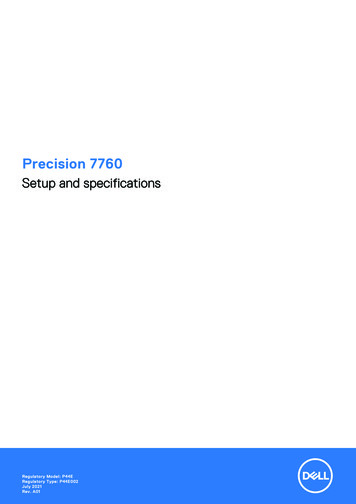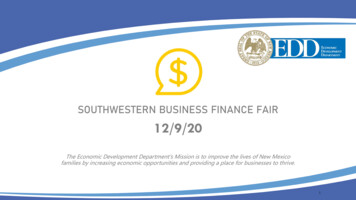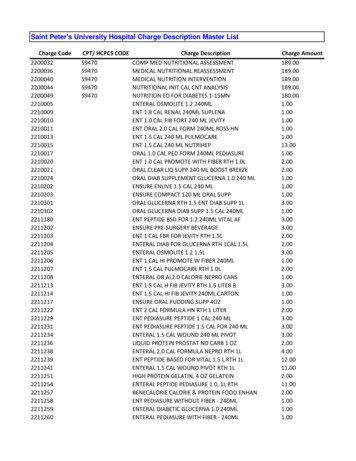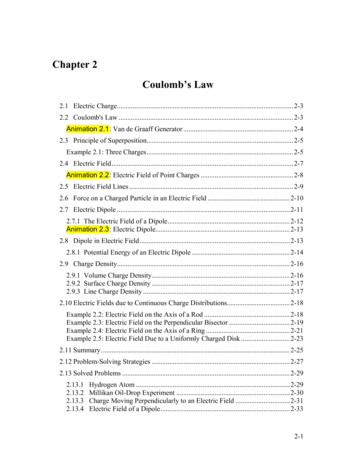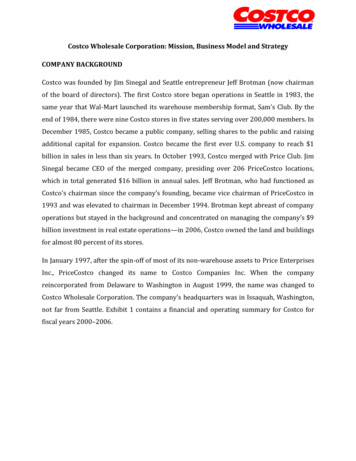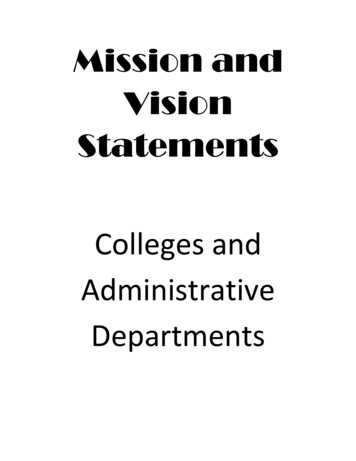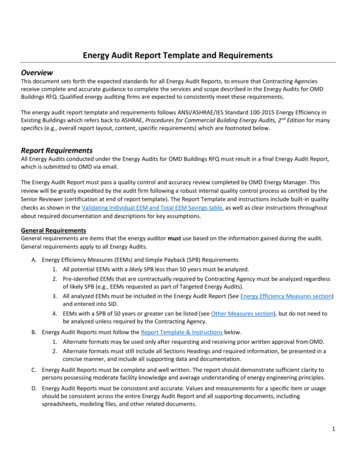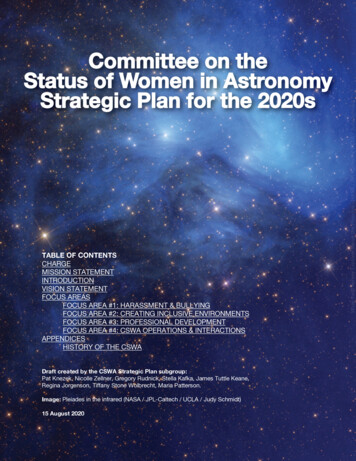
Transcription
TABLE OF CONTENTSCHARGEMISSION STATEMENTINTRODUCTIONVISION STATEMENTFOCUS AREASFOCUS AREA #1: HARASSMENT & BULLYINGFOCUS AREA #2: CREATING INCLUSIVE ENVIRONMENTSFOCUS AREA #3: PROFESSIONAL DEVELOPMENTFOCUS AREA #4: CSWA OPERATIONS & INTERACTIONSAPPENDICESHISTORY OF THE CSWADraft created by the CSWA Strategic Plan subgroup:Pat Knezek, Nicolle Zellner, Gregory Rudnick, Stella Kafka, James Tuttle Keane,Regina Jorgenson, Tiffany Stone Wolbrecht, Maria Patterson.Image: Pleiades in the infrared (NASA / JPL-Caltech / UCLA / Judy Schmidt)15 August 2020
CHARGEIn June 1979, the Council of the American Astronomical Society (AAS) created theCommittee on the Status of Women in Astronomy (CSWA) with the following charge: “CSWArecommends to the Council practical measures that the AAS can take to improve the status ofwomen in astronomy and encourage their entry into this field.”MISSION STATEMENTOur mission is to build an inclusive and self-sustaining community that supports genderequity and the success of women in astronomy. In the following, the CSWA interprets “women”to mean people who identify as female, including trans women, genderqueer women, and nonbinary people who are significantly female-identified1, and includes women with multiple,intersectional2 identities, including race, ethnicity, class, disability, and more.INTRODUCTIONThe CSWA represents one axis of the AAS’s approach to addressing issues affectingour workforce, and we work in partnership with the other AAS diversity committees andworking groups, including The Committee for the Status of Minorities in Astronomy (CSMA),The Committee for Sexual-Orientation and Gender Minorities in Astronomy (SGMA), and TheWorking Group on Accessibility and Disability (WGAD), as well as additional AAS and divisionalcommittees and working groups who seek to achieve the same goals. Individuals at theintersection of multiple underrepresented identities are especially at risk from inequities in thesystem. We therefore view these collaborations with the other AAS committees as crucial toCSWA’s mission.Since the 2009 CSWA Strategic Plan, the CSWA’s work has been critical in identifyingkey issues which led to recommendations aimed at attacking the root causes and symptoms ofharassment, discrimination, and bias in astronomy. The following is a high-level overview of theaccomplishments of this committee, and the impact it has had on transforming our communityinto a more equitable and diverse field. Over the last decade, the CSWA:1. had a consistent and active presence at all AAS meetings and in non-AAS events,increasing awareness of and discussing issues of concern to the community throughtown halls, special sessions, special events, and discussion panels;2. increased communication, raising awareness and building strong communities througha weekly email newsletter called AASWomen, the Women in Astronomy Blog, the biannual STATUS magazine, and a strong social media presence (Facebook and Twitter);3. maintained and enriched the relevant AAS web page (https://aas.org/comms/cswa);4. conducted and participated in multiple surveys assessing the status of the field;5. authored a multitude of white papers that discuss barriers faced by women inastronomy;6. initiated Climate Site Visits for Astronomy Departments;7. participated in synergistic activities with other AAS Committees (e.g. SGMA, WGAD,and the CSMA).The 2019 CSWA survey revealed that, although progress was made, the work of theCSWA is not completed, and more action needs to be taken in order to level the field. From1GeekFeminism Blog, 9/language-for-trans-inclusive-events/, accessed12/27/19.2 Crenshaw, Kimberle (1989) "Demarginalizing the Intersection of Race and Sex: A Black Feminist Critique of AntidiscriminationDoctrine,Feminist Theory and Antiracist Politics,"University of Chicago Legal Forum: Vol. 1989: Iss. 1, Article 8. Available /iss1/8.CSWA Strategic Plan, p.1
professional challenges in seeking funding and telescope time, to sociological ones (e.g.,compensation at all levels, the two-body problem, and the typically uneven distribution ofdependent caregiving responsibilities), women are still expected to bear the weight ofunrealistic expectations which discourage many exceptional individuals from following a careerin academia, stripping our field of both talent and progress. Implicit bias is a common culprit;mentorship is vital and undersupplied, and the unique role of the AAS to establish policies andbest practices becomes more urgent in order to improve the retention of women and minoritiesin astronomy. The 2019 survey also showcased that, although harassment is addressed andanti-harassment policies are in place, harassment and discrimination in astronomy is still amajor issue, with new forms of harassment emerging as the field becomes more diverse. Ourwork is both relevant and necessary to promote and support Women in Astronomy.VISION STATEMENTThe CSWA aims to encourage and support the creation of a professional astronomicalcommunity, including our committee, in which all people, regardless of gender identity andincluding those at the intersection of multiple underrepresented groups, flourish and arerepresented in proportion to their numbers in the general population.CSWA’S ASSETS AND WEAKNESSESThe CSWA has many assets. In particular, the CSWA’s reach is wide: the AASWomennewsletter reaches 1600 people weekly, and the CSWA’s website, Facebook page, Twitteraccount, and blog site reach an additional, large audience. The CSWA currently has 16members, enabling it to undertake a broad scope of activities, as described in the committee’sWorking Rules3 (a document that has yet to be adopted).Nonetheless, the CSWA also has many weaknesses. The CSWA is entirely made up ofvolunteers and has no formal budget. The CSWA was created as a single-issue group, and hassometimes struggled to keep up with the changing landscape of diversity, equity, and inclusionwork and particularly the importance of intersectionality. Additionally, the CSWA is sometimesdisconnected from other minority groups in AAS and its divisions and does not always leveragethe strengths of these other groups when planning activities. These weaknesses can limit theCSWA in achieving its objectives.CSWA ISSUES AS ETHICS ISSUESMany of the issues that the CSWA plans to address as part of this plan are, at theirheart, ethics issues and specifically related to conduct towards others. This view is echoed inthe AAS Code of Ethics4. For example, Harassment & Bullying, and Peer Review arespecifically mentioned in the AAS Code of Ethics. We hold that the ethics issues that weoutline below should be handled accordingly and with similar importance to research ethicsissues. Where appropriate in the document below we will outline the ethics implications of thevarious objectives.FOCUS AREASThe CSWA identified four major focus areas for committee work in the coming years.These are detailed in Wexler et al. (2020). Within each focus area, there are multiple high-levelobjectives. Specific projects are outlined in Table 1. In the following, the CSWA interprets"women" to mean people who identify as female, including trans women, genderqueer women,34Draft CSWA Working Rules: lDm9gwEBkS501MrALVfNtiaZtIPXo/edit.AAS Code of Ethics: https://aas.org/policies/ethics.CSWA Strategic Plan, p.2
and non-binary people who are significantly female-identified5, and includes women withmultiple, intersectional6 identities, including race, ethnicity, class, disability, and more.Focus Area #1: Harassment & Bullying1.1 Objective (Policies and procedures): Work with the AAS Board both to develop policiesand procedures that address and prevent harassment and bullying and to improvethose policies that currently exist. These policies should treat harassment & bullying asethics issues of equal importance to violations of research ethics.1.2 Objective (Training): Increase the availability and effectiveness of training activities thatwork to prevent harassment and bullying and which provide an ethical framework forreacting to instances of harassment and bullying.1.3 Objective (Advocacy): Build a framework in which targets of harassment and bullyingcan advocate for themselves and be advocated for by others.Focus Area #2 Creating Inclusive Environments for an Ethical Workplace2.1 Objective (Pipeline): Increase the percentage of women who earn doctoral degrees andwho are represented at senior levels.2.2 Objective (Two-body problem): Increase awareness of “two-body” problem issues anddevelop potential actions to alleviate these issues. We define the “two-body” problemas the attempts by individuals in a relationship to obtain employment in a geographicalregion(s) of their choosing.2.3 Objective (Caregiving/maternity): Support caregivers of all genders to ensure equitableaccess for women to scientific opportunity and activities.2.4 Objective (Accessibility): Work with the WGAD to improve efforts to advance inclusionand accessibility at AAS conferences and meetings to promote equitable access toscientific opportunity and activities.Focus Area #3: Professional Development3.1 Objective (State of the profession): Partner with the Employment Committee and socialscientists to research the state of the profession.3.2 Objective (Equitable awards and paper reviews): Advocate for an increase in equitableselection and review processes.3.3 Objective (Employment): Work with the Employment Committee to improve equitableopportunities for employment and promotion, including developing a compensationdatabase with a focus on graduate and postdoctoral compensation and improving theAAS Job Register to ensure that resources offered by AAS are accessible andinformative for women.Focus Area #4: CSWA Operations and Interactions4.1 Objective (Intersectionality): The CSWA should work to improve interfaces andinteractions with other AAS groups (e.g., other diversity committees, the DPSProfessional Development Committee) to increase awareness of intersectional issuesand emphasize the need for support of women with multiple minority identities.4.2 Objective (Operations): The CSWA should have a written set of working rules and5GeekFeminism Blog, 9/language-for-trans-inclusive-events/, accessed12/27/19.6 Crenshaw, Kimberle (1989) "Demarginalizing the Intersection of Race and Sex: A Black Feminist Critique of AntidiscriminationDoctrine,Feminist Theory and Antiracist Politics,"University of Chicago Legal Forum: Vol. 1989: Iss. 1, Article 8. Available /iss1/8.CSWA Strategic Plan, p.3
expectations of how it will operate as a committee both internally and externally. Theseshould be living documents that can be adjusted as necessary and the Committeeshould include enough members to respond to AAS and Committee concerns/issues.4.3 Objective (diversity work): Advocate for the AAS to establish a staffed and funded officeto support diversity, equity, inclusion, and accessibility efforts that are beyond thescope of the individual AAS committees. This office should also work with the chairs ofthe AAS diversity committees to improve how those committees coordinate theiractions.CSWA Strategic Plan, p.4
FOCUSAREAS:OBJECTIVES:1.1. Policies and procedures: Work with the AASBoard both to develop policies and procedures thataddress and prevent harassment and bullying and toimprove those policies that currently exist. Thesepolicies should treat harassment & bullying as ethicsissues of equal importance to violations of researchethics.1. Harassment& BullyingEXAMPLE PROJECTS:Make sure that the Wexler et al. is submitted and disseminated to the AAS Board and Determine how well we communicated ourto appropriate committees and stakeholders.recommendations to the AAS governance.Determine how effective we were in advocating forour priorities, as evidenced by whether ourrecommendations were successfully implemented bythe AAS.Work with other committees, especially employment and diversity committees, toTBDensure that policies and procedures properly address intersectional issues.Work with the AAS to continually update the AAS Code of Ethics, anti-harassmentTBDpolicies, definitions, and procedures. Make sure different policies and documents areself-consistent, and use modern definitions of harassment.Work with the AAS to strengthen its harassment reporting, investigation, andTBDsanctioning procedures, possibly including: a “bias incident response program” torespond to minor instances of harassment and bullying using a restorative approach;an escrow system for complaints; an online hub that AAS members can use to helpthem navigate reporting harassment.1.2. Training: Increase the availability andeffectiveness of training activities that work to preventharassment and bullying and which provide an ethicalframework for reacting to instances of harassment andbullying.Work with other committees, especially employment and diversity committees, toensure that the trainings are implemented within an intersectional framework. This isimportant as individuals who are members of underrepresented groups and those atthe intersections of multiple underrepresented groups are more often the targets ofharassment.Co-sponsor training sessions at AAS meetings and at institutions.1.3. Advocacy: Build a framework in which targets of In collaboration with the other diversity committees, encourage (perhaps, as aharassment and bullying can advocate for themselves statement) the AAS to develop a restorative approach to minor instances ofharassment and bullying and provide timely feedback on the proposed approach.and be advocated for by others.Work with the AAS to define the role of an advocate for targets of harassment/bullying.TBD2.1. Pipeline: Increase the percentage of women who Work with the AAS, the AAS Demographics Committee, the AAS EmploymentCommittee, and any future AAS Diversity Officer to collect demographic data,earn doctoral degrees and who are represented atspecifically as it pertains to recruitment and retention, and paying attention to thesenior levels.Determine how effective we were in contributing tothe awareness by assessing whether or not bestpractices have been developed and distributed. (Cancompare to previous studies by CSWA, past articlesinStatus?) how effective we were in addressingDetermineimpact on individuals at the intersections of multiple identities. One previouslydemonstrated method (J. Schmelz) would be to survey chairs, directors, andanalogous supervisors within the astronomy workforce to evaluate the hiring,promotion, etc. of their supervisees.2. CreatingInclusiveEnvironmentsfor an EthicalWorkplaceEXAMPLE ASSESSMENTS:Work with the AAS, SGMA, CSMA, Employment Committee, and other relevantcommittees to develop methods for attracting, hiring, retaining, and evaluating(including tenure and promotion) female-identified scientists, including those withintersectional identities.Reimplement the Women in Astronomy database, including the option to ask for selfreported demographic information that could be public.Take steps to improve the graduate and postdoctoral experience, including promotingrecommendations of the graduate education task force report, particularly as theypertain to women.2.2. Two-body problem: Increase awareness of “two- Use results of any study to work with AAS & Employment Committee to develop andbody” problem issues and develop potential actions to distribute a “best practices” guide for both employers and candidates.alleviate these issues. We define the “two-body”problem as the attempts by individuals in arelationship to obtain employment in a geographicalregion(s) of their choosing.Work with AAS and the Employment Committee to determine how the “two-body”affects the hiring and promotion of women in astronomy. One example might bethrough an NSF-funded project as described in the Wexler et al. BAAS paper.TBDTBDTBDgender disparity by an increase of parity in thestatistics.(Can compare to previous studies byCSWA, past articles in Status?)TBDTBDTBDAssess any resources that provide recommendationson mitigation strategies.Assess any data that have been collected about twobody prevalence and impact.2.3. Caregiving/maternity: Support caregivers of allgenders to ensure equitable access for women toscientific opportunity and activities.Suggest to and potentially work with AAS to incorporate implementation of family leave Determine if AAS has increased awareness of bestand caregiving policies into the Code of Ethics, including protection against retaliation. practices.2.4. Accessibility: Work with the WGAD to improveefforts to advance inclusion and accessibility at AASconferences and meetings to promote equitableaccess to scientific opportunity and activities.Work with WGAD (e.g., by offering to assist and co-signing requests) and AAS topromote establishing accessible spaces and physical accessibility in workenvironments.Work with WGAD to encourage the AAS to actively and systematically solicit feedbackfrom marginalized groups to improve experiences at AAS events.Determine if accessibility standards beyondrequirements of the Americans with Disabilities Acthave been adopted.Get feedback from post-event surveys to assess theaccessibility of AAS conferences and meetings.3.1. State of the profession: Partner with theEmployment Committee and social scientists toresearch the state of the profession.Advocate for surveys of the broad astronomy and planetary science communities.Get survey results.Work with AAS & Employment Committee to highlight (to employers via a “bestDetermine if AAS has increased awareness of bestpractices” document) that adequate family-leave and caregiving policies and resources practices.are ethics issues and that employees should be protected from retaliation for takingadvantage of these policies. These best practices should be informed by socialscience research.Work with the AAS to ensure caregiving accommodations at meetings andDetermine if AAS has increased accommodations.conferences, including having AAS work with organizers of regional meetings andconferences to help them provide and support caregiving options.Identify best-practices and implement them.3.2. Equitable awards and paper reviews: Advocate Work with the AAS to determine how prizes are awarded, and get a demographicanalysis of past prize submissions and selections.for an increase in equitable selection and reviewprocesses.3. ProfessionalDevelopment3.3. Employment: Work with the EmploymentCommittee to improve equitable opportunities foremployment and promotion, including developing acompensation database with a focus on graduate andpostdoctoral compensation and improving the AASJob Register to ensure that resources offered by AASare accessible and informative for women.4.1. Intersectionality: The CSWA should work toimprove interfaces and interactions with other AASgroups (e.g., other diversity committees, the DPSProfessional Development Committee) to increaseawareness of intersectional issues and emphasize theneed for support of women with multiple minorityidentities.4. CSWA4.2. Operations: The CSWA should have a written setOperations and of working rules and expectations of how it willInteractionsoperate as a committee both internally and externally.These should be living documents that can beadjusted as necessary and the Committee shouldinclude enough members to respond to AAS andCommittee concerns/issues.4.3. Diversity Work: Advocate for the AAS to establisha staffed and funded office to support diversity, equity,inclusion, and accessibility efforts that are beyond thescope of the individual AAS committees. This officeshould also work with the chairs of the AAS diversitycommittees to improve how those committeescoordinate their actions.Evaluate whether or not there are statistical biases inwho is nominated for, or receives prizes.Selection committee provide rubrics that standardizethe selection process.Work with the AAS to determine how press conferences are selected, and getEvaluate whether or not there are statistical biases indemographic analysis of those who participated in previous AAS press conferences.who is involved with AAS press conferences.Selection committee provide rubrics that standardizethe selection process.Work with AAS to determine how plenary talks are selected, and get demographicEvaluate whether or not there are statistical biases inanalysis of previous plenary talks to ensure gender and diversity balance in conference who gives conference plenary talks.plenary talks.Selection committee provide rubrics that standardizethe selection process.Work to ensure women are nominated for AAS prizes and prize talks.Evaluate whether or not there is a statistical increasein the proportion of nominations and awards of theseprizes and/or talks who are female-identifiedscientists, including those with intersectionalidentities.Improve AAS journal review processes by promoting dual anonymous peer-review and TBDby recommending the release of article submission and acceptance data, includingauthor and reviewer demographics.Recommend to the AAS Board the exploration and/or creation of a distanceTBDmentorship program, to assist in professional development across all career levels.Develop and implement professional development activities that are especially relevant TBDto CSWA constituents. These could include workshops on public speaking, salarynegotiation, interview skills. This could involve a budgetary request to aid indevelopment of workshops by outside agencies.Establish and formalize robust means for communicating between the differentdiversity committees (such as enlist diversity committee liaisons serving on multiplecommittees, regular email communications, etc.), keeping in mind that the burden ofliaising between different diversity committees may fall disproportionately on people atthe intersection of multiple identities.CSWA will advocate that the AAS Board, and any future AAS diversity officer, organizeregularly scheduled in-person meetings for members of CSMA, CSWA, WGAD, SGMA,and DPS PCCS during which we will develop and converge upon cross-committeegoals (e.g., annual project list/budget, strategic plans) and develop plans foraccomplishing those goals.Work with other diversity groups to organize and coordinate workshops and activitiesat AAS-sponsored meetings with themes related to recruiting, promoting, and retainingwomen in Astronomy and science in general.Assess the frequency and level of interaction withactivities across diversity committees.Assess that issues relevant across AAS diversitycommittees are brought to the attention of the AASBoard.Evaluate that the meeting actually occurs.Review effectiveness of materials and blog postsUse surveys to assess the level and impact ofcommunication with members and how to improve it.TBDTBDIn collaboration with the other diversity committees, strongly recommend establishing Evaluate how well the office has responded to CSWAan AAS Office of Diversity and Inclusion. While the AAS diversity committees canneedsprovide recommendations to the AAS, they cannot directly implement thoserecommendations.Work with the AAS Ethics Committee to recommend that the AAS hire at least oneTBDprofessional who is trained as an advocate for and supporter of targets of harassmentand bullying.Table 1: CSWA Strategic Plan Traceability Matrix, showing Focus Areas, Objectives, Example Projects, and Example Assessments.
APPENDICESHistory of the CSWAIn 2009, on the 30th anniversary of the formation of the CSWA, the committeedeveloped a new strategic plan. The 2009 CSWA Strategic Plan7 enlisted the committee to“educate our community to understand the challenges faced by women of one or moreintersections in order to facilitate a more inclusive [astronomical] community.”Since the 2009 CSWA Strategic Plan, the astronomical community has been rocked byrevelations of harassment in high-profile academic environments and abuse of power by seniormale astronomers, which led to intense discussions on how to eliminate such behaviors in allprofessional environments. The specific cases brought to light by community members,including past and active CSWA members, have caused many academic disciplines beyondastronomy to look inward and to confront issues of harassment as well. If not anything else,this highlighted the urgency for action against perpetrators, protection of victims, and the needfor proactive action from entities such as the AAS. The CSWA’s work was critical in identifyingkey issues which led to recommendations aimed at attacking the root causes and symptoms ofharassment, discrimination, and bias in astronomy.As we embark on a new strategic planning process, we first take a critical step back toreflect on the CSWA’s accomplishments during the fourth decade of its activities, which willhelp us to gain clarity on the next step(s) of our work. The following is a high-level overview ofthe accomplishments of this committee, and the impact it has had on transforming ourcommunity into a more equitable and diverse field. Over the last decade:1. The CSWA had a consistent and active presence at all AAS meetings, increasingawareness of and discussing issues of concern to the community. CSWA members ledtown halls, special sessions, special events, and discussion panels on a variety ofissues, including data-based discussions educating the community on issues such asharassment (and its various forms), discrimination, workplace bullying, stereotypethreat, and impostor syndrome. The CSWA invited active participation of allies (e.g.,217 AAS town hall, “How Men Can Help Women in Astronomy”). The CSWAencouraged strong support groups through mentoring (e.g., 218 AAS discussion“Transforming Cultural Norms: Mentoring/Networking Groups for Women andMinorities” and multiple mentoring sessions at subsequent AAS meetings)2. The CSWA increased its active presence and participation in non-AAS events/meetings,discussing harassment in scientific disciplines and examining common challenges withcommunities worldwide. These activities aimed to increase awareness, highlightchallenges, and propose solutions.3. The CSWA helped organize and participated in the Women in Astronomy III and IVconferences, which addressed the topic of women in astronomy and space sciencewith a focus on gender, generation, and minorities. Outcomes of the June 2017conference “State of the Profession,” included several white papers representing thefield, which were submitted to the 2020 Decadal Survey on Astronomy andAstrophysics. An additional white paper was published separately in the BAAS.4. The CSWA increased communication with community members, raising awareness andbuilding strong communities through:– A weekly email newsletter called AASWomen providing news items aboutwomen in science, focusing on women in science, announcements of honorsand awards given to women in science, information about programs and72009 CSWA Strategic Plan: https://aas.org/sites/default/files/2019-09/CSWA StratPlan 2009 0.pdfCSWA Strategic Plan, p.6
meetings, and postings for internships and jobs.The Women in Astronomy Blog (started in 2008) aiming to reach out to ayounger and broader audience. The blog features news articles and discussionsof issues of current interest. Although the blog’s focus overlaps with that ofAASWomen, it also provides a forum for discussion and communityengagement. In response to criticism that the blog was too focused on theperspective of straight, cis-gendered, white women, the CSWA worked onsoliciting contributions from a more diverse set of bloggers which enriched thediscussion with topics such as intersectionality and the various ways it ismanifested, and the importance of scientists making their voices heard.– The bi-annual STATUS magazine, discussing items of interest.– A strong social media presence (Facebook and Twitter), which, among others,advertised and shared content of the AASWomen newsletter and the blog.The CSWA maintained and enriched the relevant AAS web page (www.aas.org/cswa)with links to other sites and to on-line articles of interest. A notable new feature is the“Resources” section which includes a full set of resources that detail the benefits ofdiversity.The CSWA conducted and participated in multiple surveys assessing the status of thefield, such as the CSWA 2013 Demographics Survey, a survey on dual-career academiccouples (2013-2014), and “The CSWA Survey on Workplace Climate” (2015), and thesurvey “Facing the Future: The CSWA Seeks Your Input on Our Community Needs inthe 2020s” (2019) . Survey outcomes were shared with the community, discussedextensively, and used to guide further actions on policy and information.The CSWA author ed a multitude of white papers that discuss barriers faced by womenin astronomy and are disseminated worldwide.The CSWA initiated Climate Site Visits for Astronomy Departments (2012), aiming atincreasing the committee’s knowledge about problems experienced nationally bywomen students, postdocs, and faculty in astronomy, work with departments to identifyproblems, suggest means by which the department might solve those problems andimprove the climate for women. This activity led the An AAS to form the Site-VisitOversight Committee (SVOC) was later also formed, charged with overseeing “climate”site visits to departments and institutes, with emphasis on issues faced by allmarginalized groups, and developing procedures for those visits. A “best practices”document was developed, which was approved for release by the AAS Board at itsJune 2018 meeting.The CSWA participated in synergistic activities with other AAS Committees (e.g. SGMAand the CSMA). Some notable activities included:– The CSWA co-sponsored
CSWA Strategic Plan, p.2 professional challenges in seeking funding and telescope time, to sociological ones (e.g., compensation at all levels, the two-body problem, and the typically uneven distributi


